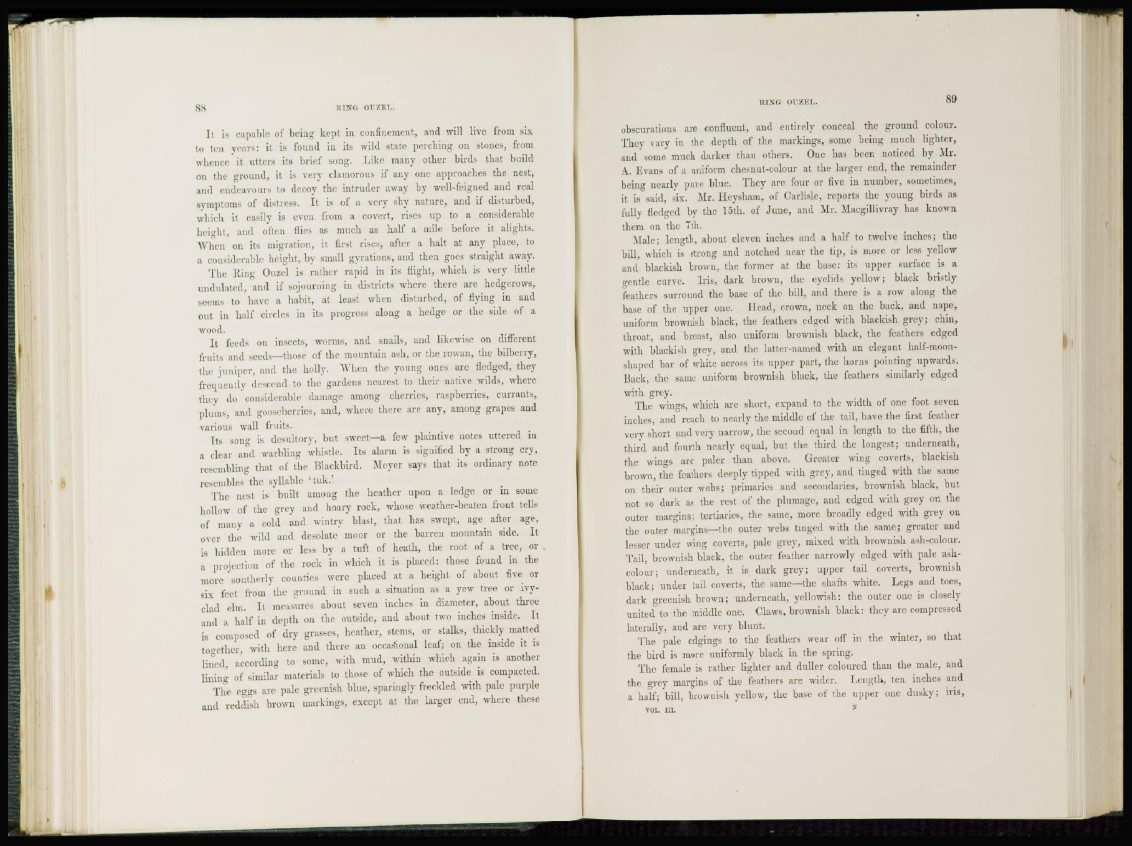
8* RING OUZXL.
I t is capable of being kept in confinement, and will live from six
to ten years: ii is found in its wild state perching on stones, from
whence it utters its brief song. Like many other birds that build
on the ground, it is very clamorous if any one approaches the nest,
and endeavours to decoy the intruder away by well-feigned and real
symptoms of distress. It is of a very shy nature, and if disturbed,
which it easily is even from a covert, rises up to a considerable
height, and often Hies as much as half a mile before it alights.
When on its migration, it first rises, after a halt at any place, to
a considerable height, by small gyrations, and then goes straight away.
The King Ouzel is rather rapid in its flight, which is very little
undulated, and if sojourning in districts where there are hedgerows,
seem-- to have a habit, at least when disturbed, of flying in and
out in half circles in its progress along a hedge or the side of a
wood.
It feeds on insects, worms, and snails, ami likewise on different
fruits and seeds—those of the mountain ash, or the rowan, the bilberry,
the juniper, anil the holly. When the young ones are fledged, they
frequently descend to the gardens nearest to their native wilds, where
they do considerable damage among cherries, raspberries, currants,
plums, and gooseberries, and, where there are any, among grapes and
various wall fruits.
Its song is desultory, but sweet—a few plaintive notes uttered in
a clear and warbling whistle. Its alarm is signified by a strong cry,
resembling that of the Blackbird. Meyer says that its ordinary note
resembles the syllable 'tuk.'
The nest is built among the heather upon a ledge or in some
hollow of the grey and hoary rock, whose weather-beaten front tells
of m a n y a cold and wintry blast, that has swept, age after age,
o\ er the wild and desolate moor or the barren mountain side. It
is hidden more or less by a tuft of heath, the root of a tree, or
a projection of the rock in which it is placed: those found in the
more southerly counties were placed at a height of about five or
six t'eet from the ground in such a situation as a yew tree or ivyclad
elm. It measures about seven inches in diameter, about three
and a half in depth on the outside, and about two inches inside. It
is composed of dry grasses, heather, stems, or stalks, thickly matted
together, with here and there an occasional leaf; on the inside it is
lined, according to some, with mud, within which again is another
lining of similar materials to those of which the outside is compacted.
The e<;-gs are pale greenish blue, sparingly freckled with pale purple
and reddish brown markings, except at the larger end, where these
RING Ol'ZEL. 89
obscurations are confluent, and entirely conceal the ground colour.
They \ ary in the depth of the markings, some being much lighter,
and some much darker than others. One has been noticed by Sir.
A. Evans of a uniform chesnut-colour at the larger end, the remainder
being nearly pure blue. They are four or five in number, sometimes,
it is said, six. Mr. Hcysham, of Carlisle, reports the young birds as
fully fledged by the 15th. of June, and Mr. Macgillivray has known
them on the 7th.
Male; length, about eleven inches and a half to twelve inches; the
bill, which is strong and notched near the tip, is more or less yellow
and blackish brown, the former at the base: its upper surface is a
gentle curve. Iris, dark brown, the eyelids yellow; black bristly
feathers surround the base of the bill, and there is a row along the
base of the upper one. Head, crown, neck on the back, and nape,
uniform brownish black, the feathers edged with blackish grey? chin,
throat, and breast, also uniform brownish black, the feathers edged
with blackish grey, and the latter-named with an elegant half-moonshaped
bar of white across its upper part, the horns pointing upwards.
Back, the same uniform brownish black, the feathers similarly edged
with grey.
The wings, which are short, expand to the width of one foot seven
inches, and reach to nearly the middle of the tail, have the first feather
very short and very narrow, the second equal in length to the fifth, the
third and fourth nearly equal, but the third the longest; underneath,
the wings are paler than above. Greater wing coverts, blackish
brown, the feathers deeply tipped with grey, and tinged with the same
on their outer webs; primaries and secondaries, brownish black, but
not so dark as the rest of the plumage, and edged with grey on the
outer margins; tertiaries, the same, more broadly edged with grey on
the outer margins—-the outer webs tinged with the same; greater and
lesser under wing coverts, pale grey, mixed with brownish ash-colour.
Tail, brownish black, the outer feather narrowly edged with pale ashcolour;
underneath, it is dark grey; upper tail coverts, brownish
black; under tail coverts, the same—the shafts white. Legs and toes,
dark greenish brown; underneath, yellowish: the outer one is closely
united to the middle one. Claws, brownish black: they are compressed
laterally, and are very blunt.
The pale edgings to the feathers wear off in the winter, so that
the bird is more uniformly black in the spring.
The female is rather lighter and duller coloured than the male, and
the grey margins of the feathers are wider. Length, ten inches and
a half; bill, brownish yellow, the base of the upper one dusky; iris,
VOL. m. x